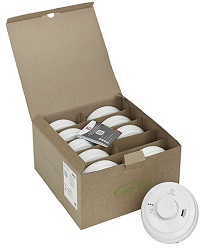
Aico has launched its new eco-fit range of alarms, as part of its drive to be more environmentally conscious and sustainable. The eco-fit range is exclusive to the Aico 3000 Series of heat and carbon monoxide multi-sensor alarms, which contain intelligent sensors and utilise the company’s SmartLINK wireless technology to integrate with its Gateway for remote monitoring.
While retaining all of the features of the 3000 Series, the new eco-fit range is available as head unit only, meaning there are no easi-fit bases, screw packs or dust covers included. This is due to the easi-fit base being universal to all current Aico products, so unless damaged, the bases do not need replacing and are often redundant, contributing to waste plastic. As a result, the eco-fit range provides a reduction in plastic of 100%, according to the company, and is therefore ideally suited for upgrading and retrofitting properties where easi-fit bases are already in situ.
In the UK, it is estimated that five million tonnes of plastic is used every year, nearly half of which is packaging, with plastic packaging accounting for nearly 70%2 of our plastic waste. The eco-fit range is therefore available in packs of 10 in minimal, fully recyclable packaging, with a reduced instruction leaflet. As a more sustainable alternative, the solution is said to use up to 58% less cardboard and paper than individual alarms.
Aico Product Development Manager, Michael Wright, commented: “The new eco-fit range has been created with sustainability in mind. Aico is committed to reducing waste where possible and providing high quality, sustainable products. eco-fit packs are the ideal solution where existing easi-fit bases are already installed as they provide a simple way to install new alarms with minimal packaging waste. The packaging itself is also fully recyclable, all of which helps to support users of our products to reduce their waste when installing alarms”.
As part of the company’s wider commitment to sustainability, its new HQ was designed with four acres of landscaping, a large pond, habitats for natural wildlife and a solar garden on the roof, acting as a renewable energy source











